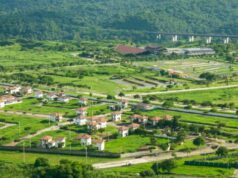
CITY OF SAN FERNANDO, Pampanga (PIA) — Bangko Sentral ng Pilipinas (BSP) urged Central Luzon residents to do cashless transactions by using various digital payment platforms.
BSP Head Office Payments Policy and Development Department Officer Aldwin Nacional underscored that they created the National Retail Payment System (NRPS) framework which defines policies and standards in electronic retail payment operations.
“The effective implementation of its principle in interoperability enables consumers to transfer funds from one account to another account in any participating bank, non-bank or e-wallet account. There will be an easy transfer,” he emphasized.
Electronic Fund Transfer facilities under the NRPS include PESONet which is used for government payments or collections, supplier payments, payroll, and loan and dividend payouts.
It is a batch electronic fund transfer used for big transactions as these can transfer any amount. It is also an alternative for checks and utilized for planned and non-urgent transactions.

Another platform is the electronic government payment (eGovPay) which simplifies payment acceptance for government agencies, enhances the government’s data management and reporting processes, reduces manual operations, and improves the reconciliation process.
BSP also created the InstaPay which is used for domestic remittance, e-commerce, bills payment, and other immediate low-value payments.
It is a real-time low-value electronic fund transfer used by individuals and small businesses. It can be an alternative for cash and coin and is anytime available.
Apart from these, QRPH allows person-to-person funds transfer or remittance or purchase of goods or services via a quick response code.
BillsPayPH is likewise a domestic payment platform which enables customers to settle their bills and other periodic or recurring financial obligations.
Customers or payors will not be charged any fees for paying their bills using this platform.
Moreover, Nacional said BSP is pushing for cross-border payments with the neighboring countries in Southeast Asia.
“We have to have a linkage with their payment system for us to really benefit from international trade, so we are setting up bilateral and multilateral linkages with our neighbors. We try to link our InstaPay to our neighbors,” he added.
Meanwhile, BSP also revived its wholesale Central Bank Digital Currency initiative dubbed as Project Agila.
This is a form of digital money denominated in the national unit of account and are direct liabilities of the central bank.
Benefits of e-payment platforms
Nacional encouraged individuals and businesses to utilize available e-payment platforms as these provide more benefits compared to physical transactions.
“For businesses, these provide improved efficiency and reduced operating costs compared to handing cash and checks. Over time, savings from these operating costs can build up and may be put into productive use,” he said.
Digital payment can also aid in the development of micro, small, and medium enterprises in the Philippines as these can improve their participation in e-commerce and supply chain management, and allow them to participate in international trade.
It can likewise help government institutions to minimize their leaks through more efficient collection, better audit trail, enhanced transparency, and more efficient disbursement of social aid to target beneficiaries.
“Digitalizing government payments in developing countries like the Philippines could save around .8 to 1.1 percent of the Gross Domestic Product which is equivalent to US$ 220 to 320 billion annually, so there is a potential for a lot of savings when we full go fully digital,” he explained.
Growth of digital payment transactions in the Philippines
Nacional shared that there is an observed growth in digital payments volume which gives the country a greater opportunity to develop further its digital payments sector.
“About 42.1% of payment transactions in 2022 were made digitally, compared to the 30.3% made in 2021…This is an achievement for the country,” he cited.
The observed growth in digital payments volume was primarily driven by merchant payments, person-to-person payments, and business to person salaries and wages.
Merchant payments increased to 1,508 million in 2022 from 1,112 million in 2021 while person-to-person payments increased to 300 million in 2022 from 157 million in 2021.
Private enterprises are shifting to digital means of disbursing their employees’ salaries and wages as digital payments for these increased to 45 million in 2022 from 32 million in 2021.
Cyber hygiene among users
Given these, Nacional said that clients should be responsible in the use of digital financial services as these can be subject to cybersecurity threats.
“Cyber hygiene is a shared responsibility between the user, regulator, and financial institution… Cybersecurity is everyone’s responsibility,” he pressed.
BSP reminded its clients to keep in mind that strange or suspicious messages or persons should not be entertained.
They should also use an exclusive and strong password with a two-step verification process.
It added that transaction history should be checked and suspicious transactions should be reported. Alert notifications should likewise be enabled.(CLJD/JLDC-PIA 3)




